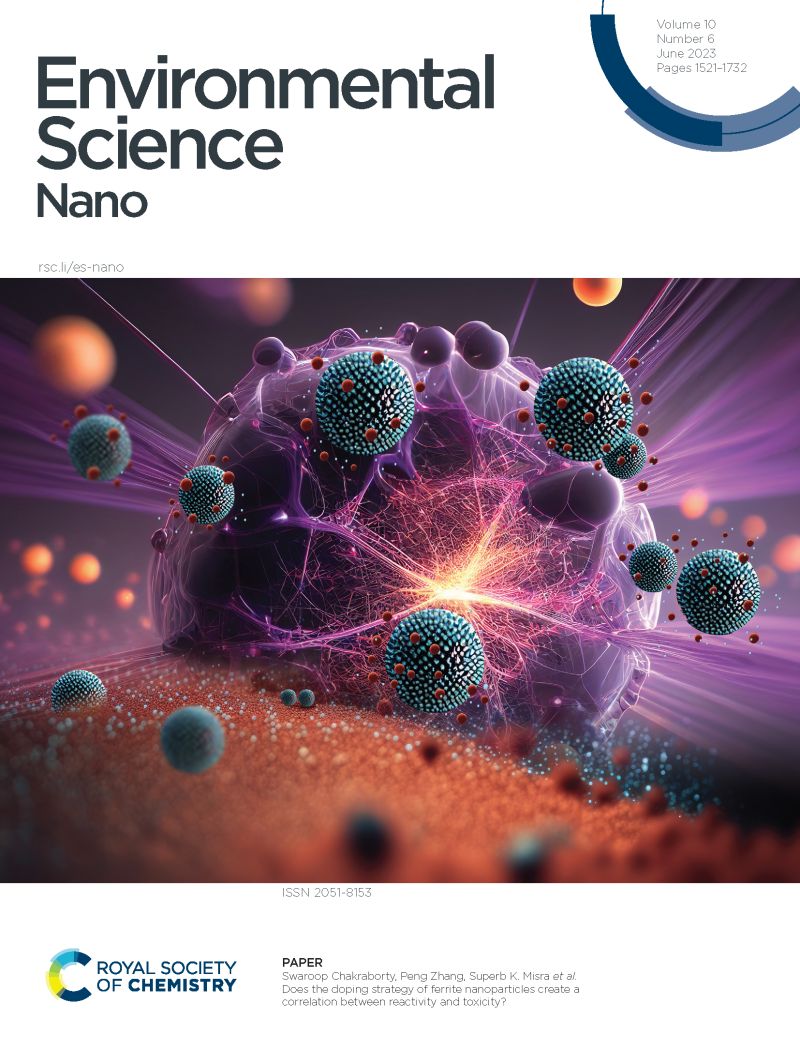防晒霜中TiO2和ZnO纳米颗粒释放到自然水体:SP ICP-ToF-MS检测和鉴别
IF 5.1
2区 环境科学与生态学
Q1 CHEMISTRY, MULTIDISCIPLINARY
引用次数: 0
摘要
从生态风险的角度来看,区分工程纳米颗粒(ENPs)与天然纳米颗粒(NNPs)是很重要的。本研究的目的是表征和量化二氧化钛和氧化锌纳米颗粒(NPs),这些纳米颗粒在两次短期暴露(~ 15分钟和~ 60分钟)后,从两种商用防晒霜中释放到三种水性基质(超纯、硬和软天然水)中。采用电感耦合等离子体飞行时间质谱仪(ICP-ToF-MS)检测单粒子(SP)中质量电荷比(m/z)在26 ~ 210 amu之间的元素。研究了不同NPs的元素组成、质量分布和同位素比值(47Ti/49Ti和66Zn/68Zn),以确定在多大程度上可以区分天然NPs和人工NPs。离子交换树脂与ICP-ToF-MS的耦合导致锌的背景信号降低,从而检测到相当小的氧化锌纳米颗粒(在ICP-ToF-MS上的检测限为~ 53 nm)。对于这两种商用防晒霜,锌主要以溶解形式释放,60分钟后几乎所有的锌都低于尺寸检测限或吸附在NNP上。SP-ICP-ToF-MS分析结果表明,与天然NPs相比,防晒霜中检测到的NPs主要含有单一元素。元素比率有助于区分ENP和NP,但同位素比率(Ti或Zn)在这种情况下不是区分NP的因素。Spearman秩分析提供了一个额外的指标来区分不同的颗粒类型。本文章由计算机程序翻译,如有差异,请以英文原文为准。
Release of TiO2 and ZnO nanoparticles from sunscreens into natural waters: detection and discrimination from natural particles using SP ICP-ToF-MS
From an ecological risk perspective, it is important to differentiate engineered nanoparticles (ENPs) from naturally occurring nanoparticles (NNPs). The aim of this research was to characterize and quantify titanium dioxide and zinc oxides nanoparticles (NPs) that were released from two commercial sunscreens into three aqueous matrices (ultrapure, hard and soft natural waters) after two short term exposures: ∼15 min and ∼60 min. An inductively coupled plasma time-of-flight mass spectrometer (ICP-ToF-MS) was used to detect elements with mass to charge (m/z) ratios ranging from 26 to 210 amu within single particles (SP). The elemental compositions, mass distributions and isotopic ratios (47Ti/49Ti and 66Zn/68Zn) of the individual NPs were investigated in order to determine to what extent it was possible to discriminate the natural and engineered NPs. The coupling of an ion-exchange resin to the ICP-ToF-MS resulted in a reduced background signal for zinc, leading to the detection of reasonably small zinc oxide nanoparticles (size detection limit of ∼53 nm on the ICP-ToF-MS). For both commercial sunscreens, Zn was primarily released as dissolved forms, with nearly all of the Zn found below the size detection limits or adsorbed to NNP after 60 minutes. Based upon the SP-ICP-ToF-MS results, the detected NPs in the sunscreens mainly contained single elements, in contrast with the natural NPs. Elemental ratios were helpful to distinguish the ENP from NP, but isotopic ratios (Ti or Zn) were not a distinguishing factor for the NP, in this case. Spearman rank analysis provided an additional index to distinguish the different particle types.
求助全文
通过发布文献求助,成功后即可免费获取论文全文。
去求助
来源期刊

Environmental Science: Nano
CHEMISTRY, MULTIDISCIPLINARY-ENVIRONMENTAL SCIENCES
CiteScore
12.20
自引率
5.50%
发文量
290
审稿时长
2.1 months
期刊介绍:
Environmental Science: Nano serves as a comprehensive and high-impact peer-reviewed source of information on the design and demonstration of engineered nanomaterials for environment-based applications. It also covers the interactions between engineered, natural, and incidental nanomaterials with biological and environmental systems. This scope includes, but is not limited to, the following topic areas:
Novel nanomaterial-based applications for water, air, soil, food, and energy sustainability
Nanomaterial interactions with biological systems and nanotoxicology
Environmental fate, reactivity, and transformations of nanoscale materials
Nanoscale processes in the environment
Sustainable nanotechnology including rational nanomaterial design, life cycle assessment, risk/benefit analysis
 求助内容:
求助内容: 应助结果提醒方式:
应助结果提醒方式:


